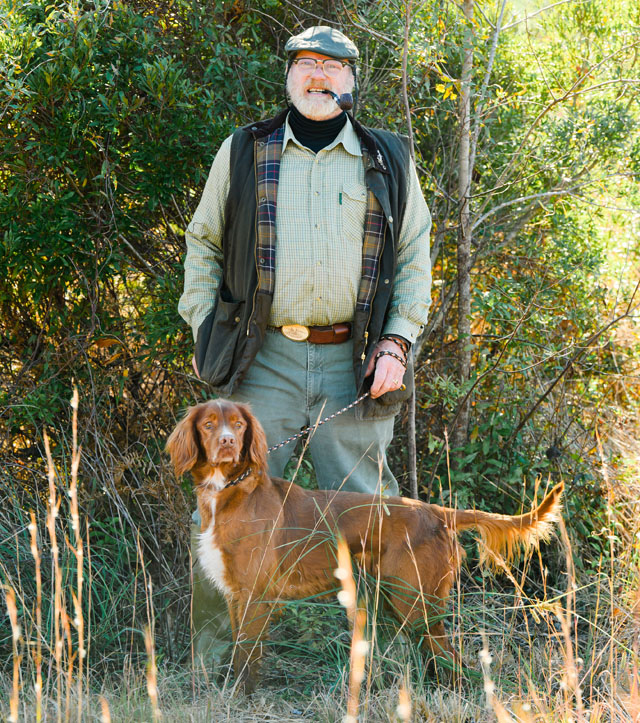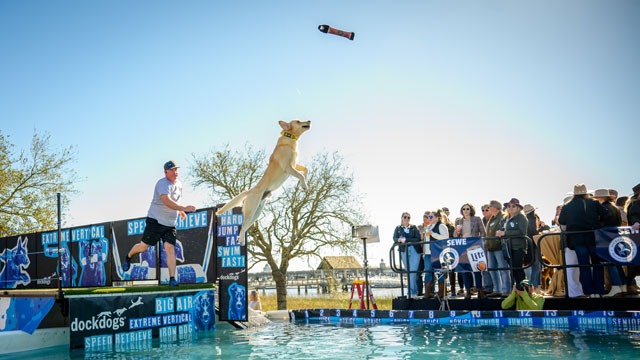The Bird Dog Whisperer
03 Jan 2024
Ray Godwin has spent decades training magnificent working breeds
By Jenny Peterson
Photos by Priscilla Thomas

“It’s all about manners when you’re hunting,” said Ray Godwin on his 85-acre shooting preserve in Holly Hill, SC where he has trained over 6,000 bird dogs to retrieve, mark and expertly rouse game birds from the brush over his storied career.
“You can’t have your dog running around bothering somebody else or bothering someone else’s dog. If your dog breaks if a fish flashes in the water, then that’s going to scare ducks that might have otherwise come flying in.”
Bird dogs have long been a hunter’s best friend and working companion, performing a variety of tasks, from retrieving a downed bird from a waterway, using “pointer” skills to sniff out a covey of birds in an underbrush, or encircling birds in a bush to “flush” them out and make them take flight.
(Godwin explains that manners also applies to sportsmen, who are only supposed to shoot at birds that are in flight, not when they are under the brush or wading in the water.)
Godwin has spent decades training magnificent working breeds through Webfoot Retrievers dog training to be elite master hunters. His canine students—chocolate and yellow labradors, Boykin spaniels, Nova Scotia duck tolling retrievers, English cocker spaniel and more—have hundreds of ribbons and junior and senior master hunter designations.
Godwin methodically teaches these dogs to sit very still in wooded and grassy areas despite many distractions; not be shy when hearing shotgun shots; exhibit a seemingly impossible amount of patience and self-control to stay put at their owner’s left side even as birds fall from the sky or flail in the water; not move until they hear their name called by their owner; when “sent” to retrieve, instinctively know to take the straightest path there and back. Perhaps the most extraordinary part of the process is that on top of all of that, the dogs are trained to not further damage the birds, or attempt to chomp on them on the journey back to the owner.
“It’s a firm but gentle mouth. I strive for dogs to be able to pick up a raw egg without breaking it and pick up a sledgehammer without dropping it,” Godwin said. “They have to be able to pick up a 20-pound goose or a six-ounce quail. They’re taught to pick up anything we tell them to, bring it back and hold it just right.”
A self-proclaimed dog whisperer, Godwin grew up in West Ashley hunting the grounds where the Citadel Mall now stands and started training and competing with hunting dogs when he was just 13 years old. He now owns nine dogs, many retired hunting dogs.
“When I was very young, I had a dog I communicated with and it seemed like we were speaking the same language. The dogs teach me—every dog has taught me a different part of how to train them,” Godwin said.
At Webfoot Retrievers, labradors, spaniels, pointers, setters and other working breeds live on Godwin’s property for 4-6 months full-time to get a command of the sport and up to a year for high-level master hunting skills. Godwin trains 6-8 dogs at a time, ideally young dogs, on his peaceful, sprawling grounds where he recreates hunting courses.
There are open fields and hills, tall grass and brush, ponds with logs deliberately placed into the waterway to replicate fallen trees, so that the dogs become familiar with landscapes and every scenario they may encounter in nature.
“We don’t hunt on a golf course so I can’t have all mowed grass; I have to have cover, so dogs learn to run through the bushes in a straight line,” Godwin said. Dogs practice skills and drills with both live birds and decoys across the property.
On any given day, these beautiful breeds with spotted coats and floppy ears can be seen swiftly crisscrossing the terrain to retrieve items with seemingly very little instruction other than four simple words: here, heel, sit, stay, mark.
There is an ease in which Godwin relates to the dogs; there’s no yelling or strong arming if a dog misses a mark and on the other hand, he doesn’t use treats when he trains. Rather, Godwin’s method uses an incredible amount of patience and a robust amount of praise and affection when the dogs complete a task.
“I train them to want my praise,” Godwin said. “In the wild, a K-9 wolf or coyote, when they get a bird, they eat it and that’s their reward. I have to switch that reward to my praise. They have to bring me what would be their food and give it to me without breaking a feather on it (simply) because they want me to pet them.”
Webfoot Retriever dogs are laser-focused. They jump into murky waters with no fear. It’s magical to watch how Godwin is able to train dogs on high-level tasks, such as retrieving two or even three fallen birds. They’re taught to retrieve one at a time, in the exact order in which the birds fell.
“You know the old saying, ‘A bird in the hand is better than two in the bush?’” Godwin said. “We don’t want a dog to go out there and mess around and try to pick up two birds and both of them to get away. The task is to bring me the one you got and then we’ll get the next one.”
Best Practices
The Webfoot Retrievers method for training dogs is time and love.
Despite these dogs already possessing the natural instinct for the hunting work, all training starts with obedience, Godwin said. Webfoot Retrievers also offers basic obedience training, with clients coming from all over the country and Canada.
“A dog is going to test everybody and it’s a matter of repetition,” Godwin said. “We break down all parts of the job to sit and stay first, have them looking in the right direction next, ‘staying’ when I throw the (decoy bird), wait until I send them, have them pick it up, bring it back, go back into ‘heel’ position and stay. It all has to be steady.”
Owners come to the property once a month to work with Godwin and their dogs on learning the commands—and learning Godwin’s style on offering more praise than correction.
“Sometimes the owners are slower to catch on than dogs,” Godwin said.
A well-trained dog isn’t only about manners, it’s about safety in a hunting environment. “Heel” is always the dog on the left side so owners don’t trip over them. Dogs “stay” until their names are called to retrieve, as simply hearing a shot doesn’t necessarily mean a bird has been hit.
What sets Godwin apart is his true understanding of dogs’ behaviors and temperament, get them to listen and understand tasks and, perhaps more important of all, train them in the urge to please above all else. It takes patience and a fair amount of psychology.
“Dogs can have a bad day,” Godwin said. “If I come out with a dog and I know what he knows how to do, but he can’t do it that day, we will come out here and do something really basic and simple, let him succeed at it and then quit,” Godwin said. “I don’t want to stop training when they’ve made a mistake. I want to stop for the day when they’ve done something perfect.”
Learn more about Webfoot Retrievers and meet Godwin and his dogs and former canine students at the Southeastern Wildlife Exposition at Marion Square from Feb. 16-18 or visit www.webfootretrievers.net.











